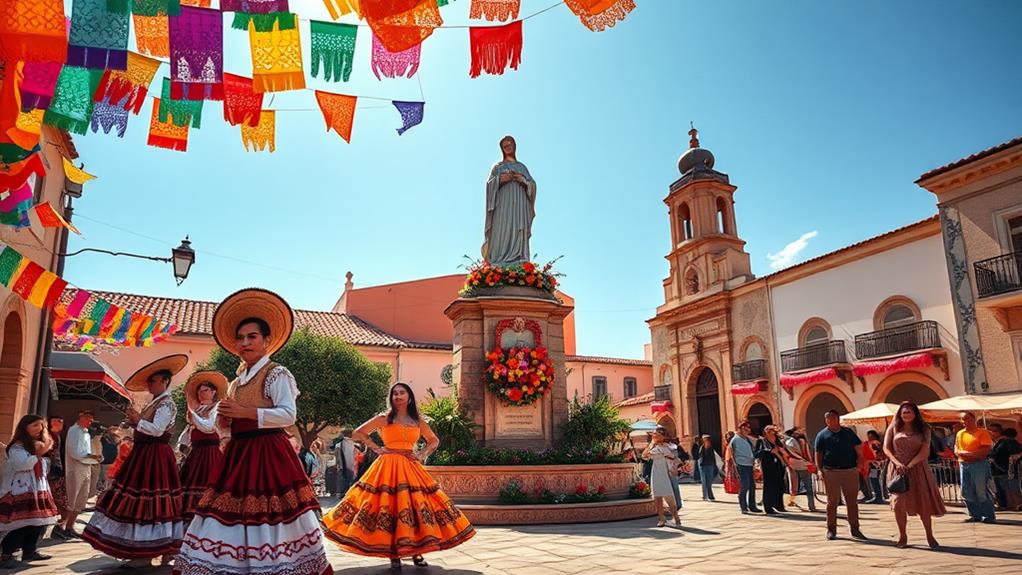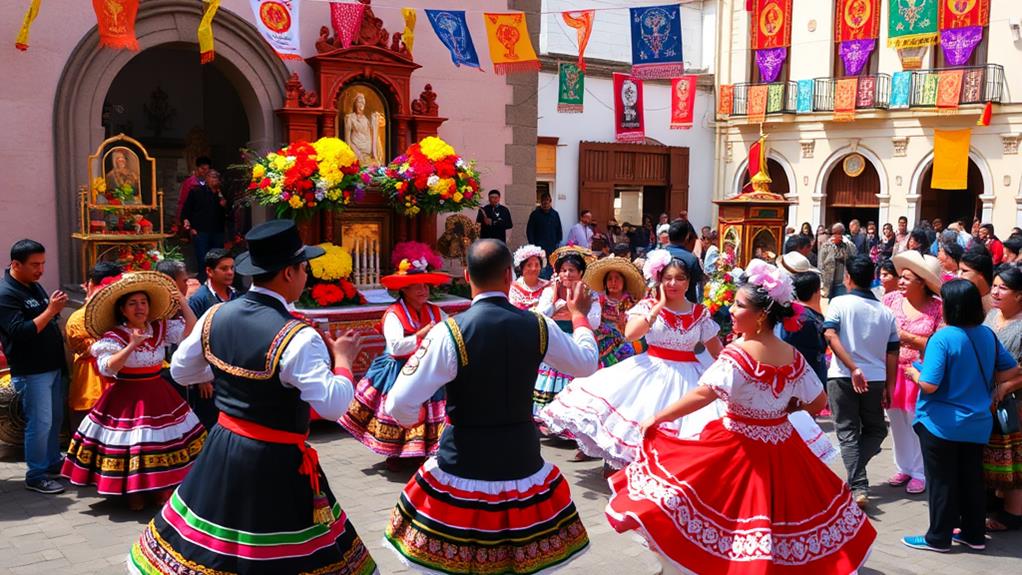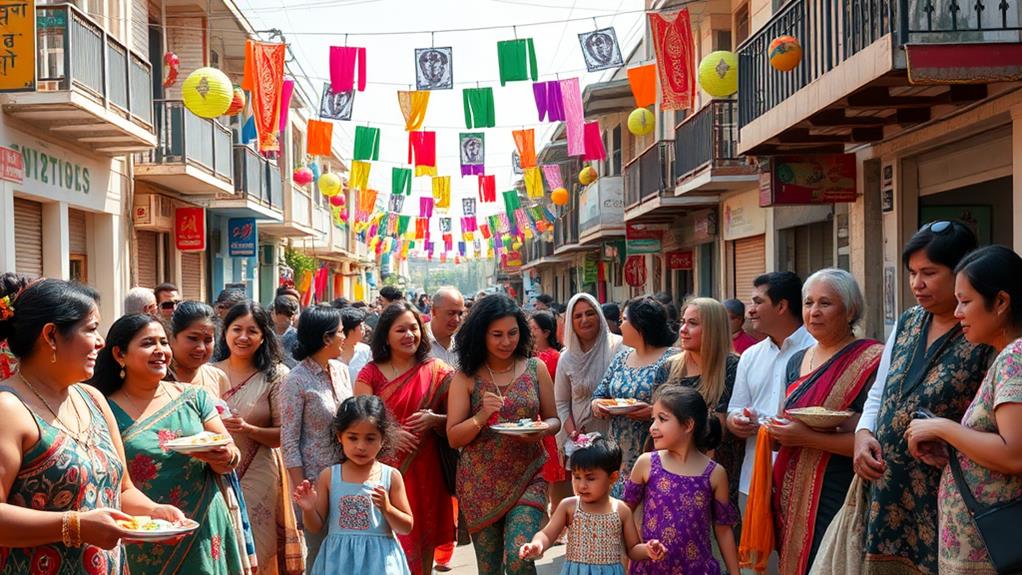Fiesta celebrations bring communities together to honor patron saints and strengthen social bonds. During these vibrant events, locals wear traditional costumes and participate in lively dances, sharing regional dishes and showcasing their cultural heritage.
Each feast day begins with masses and processions, which foster a deep sense of devotion and gratitude among participants. The aroma of traditional cuisine fills the air, bringing families together in a spirit of hospitality.
For example, in Mexico, the Fiesta de la Vendimia celebrates the grape harvest with parades, music, and traditional foods like empanadas and tamales.
These festivities embody collective joy and resilience, inviting everyone to celebrate shared heritage and connections. By participating in fiestas, communities come together, reinforcing social ties and preserving cultural traditions.
Historical Background of Fiesta

Fiestas in the Philippines: A Blend of Devotion and Culture
Historically, fiestas in the Philippines combine religious devotion with vibrant local customs. These festivities originated during Spanish colonization to commemorate the feast days of patron saints. Each town has a designated patron saint, and the fiesta centers around that saint's specific feast day.
This tradition honors religious figures and reflects local identity and community spirit.
Towns are often named after their patron saints, highlighting the historical significance of these figures in Filipino culture. Over the years, fiestas have evolved, incorporating pre-Hispanic rituals alongside Roman Catholic practices.
This fusion creates a unique expression of cultural heritage. In this lively atmosphere, communities come together, showcasing their distinct traditions, food, and music – all in honor of their patron saints.
It's a celebration of faith and unity, deeply ingrained in the Filipino way of life.
Religious Significance
Fiestas in the Philippines hold deep religious significance, uniting communities in shared devotion. Each town honors its designated patron saint, with festivities typically aligned with the saint's feast day.
Masses and processions are an integral part of these celebrations, allowing townsfolk to express their faith and gratitude.
The novena, a nine-day prayer, serves as a powerful communal ritual, where locals come together in collective reverence. This ritual is a vital part of the fiesta, taking place in the nine days leading up to the celebration.
The blending of local customs and Roman Catholic traditions is a distinct feature of these fiestas. This fusion is a reflection of the historical influence of Spanish colonization, enhancing the spiritual atmosphere.
Rituals acknowledge the blessings and protection bestowed by the patron saints, permeating the air with faith and gratitude.
These fiestas become a vital part of spiritual heritage, reinforcing community bonds and ensuring that the legacy of devotion continues to thrive among generations.
Cultural Heritage Showcase

Fiestas: A Celebration of Cultural Heritage
Vibrant Parades and Traditional Costumes
During fiestas, colorful parades take over the streets, showcasing a community's rich cultural heritage.
Families prepare for this annual celebration, eager to share their traditions and artistry. In major cities or regions, these festivities become a cultural heritage showcase, highlighting local artistry through traditional costumes and lively dances.
Rhythmic Beats and Regional Talents
Live music fills the streets, highlighting regional talents and preserving indigenous art forms. Groups compete to present captivating displays, fostering community pride and a sense of ownership over shared traditions.
Participants engage in folk games and street dancing, actively connecting with their historical narratives.
Local Organizations and Artists Add Depth
The involvement of local organizations and artists ensures that cultural expressions thrive.
These celebrations aren't just about revelry; they're vital threads in the fabric of community identity. Each event weaves stories of the past into the present, bridging generations and reinforcing bonds among families and friends, all while honoring the cultural heritage that defines them.
How has Globalization Affected Traditional Fiesta Celebrations in the Philippines?
Globalization impact filipino religious beliefs has greatly affected traditional fiesta celebrations in the Philippines. With the influence of modernization and outside cultures, some traditional practices and customs during fiestas have been altered or adapted to fit the changing societal norms. This has led to a blend of old and new traditions during these celebrations.
Culinary Extravaganza
Food Unites the Community
During the fiestas, the smell of traditional dishes fills the air, bringing people together in a vibrant culinary celebration.
Families showcase their unique specialties, revealing regional flavors and cooking techniques that reflect their heritage. At food stalls, local delicacies are on display, highlighting the hard work of local farmers and culinary artisans. These dishes tell stories about the community's history and culture.
Hospitality Through Food
Filipino hospitality is embodied through community-wide food-sharing during the holidays.
Homes open their doors to friends, relatives, and visitors, offering a feast that's more than just food – it's a symbol of love and generosity. Cooking competitions add to the excitement, where local chefs and home cooks demonstrate their skills, competing for recognition and prizes that showcase their culinary expertise.
A Feast for the Senses
Weeks of preparation culminate in extravagant spreads that celebrate cultural pride.
Each dish tells a story, connecting generations and strengthening community bonds. This culinary extravaganza transforms the fiestas into a sensory experience, making every bite a celebration of life and togetherness.
Community Bonds and Involvement

Community Bonds Flourish During Fiestas
During celebrations, community bonds strengthen as people of all ages and backgrounds come together to honor their patron saint.
Local organizations, businesses, and residents collaborate in preparations, enhancing community ties and creating a shared sense of ownership over the fiestas. This unity is evident in each parade and traditional dance, which serves as a platform for cultural expression and reinforces community identity and pride.
Hospitality and Generosity Bring People Together
As you walk through the vibrant streets, you'll notice families opening their homes and sharing food, reflecting the deep-rooted Filipino values of generosity and togetherness.
Each shared meal not only feeds people but also strengthens social connections among neighbors. You might find yourself exchanging stories with someone you've just met, bound by the shared joy of the celebration.
Fiestas Embody the Spirit of Community
These celebrations are more than just traditions; they embody the spirit of the community.
Each event is a thread woven into the fabric of community bonds, making every celebration a testament to the power of togetherness.
Questions and Answers
Why Do People Celebrating Fiestas in Honor to Their Patron Saints?
Fiestas in honor of patron saints promote cultural heritage and community unity. These celebrations showcase traditional practices that have been passed down through generations, highlighting local customs during processions and rituals.
For example, in Mexico, the Fiesta of the Virgin of Guadalupe honors the country's patron saint with colorful processions, traditional dances, and delicious food. This vibrant celebration strengthens community bonds and reinforces the unique identity of the community.
What Do You Call the Festival Celebrated in Honor of the Patron Saint?
A festival celebrated in honor of a patron saint is commonly referred to as a "fiesta."
A fiesta embodies rich cultural traditions, showcasing community involvement through various activities. For instance, it often features colorful parades that bring people together and festive activities that promote social bonding.
Religious significance is a vital aspect of these celebrations, with rituals and prayers marking the occasion.
This blending of faith and festivities creates a unique atmosphere that showcases the beauty of local heritage.
What Is the Fiesta of Patron Saint?
The Fiesta of the Patron Saint: A Celebration of Culture and Community
The fiesta of the patron saint is a vibrant celebration that showcases cultural traditions.
During this event, community gatherings thrive, as people come together to participate in religious observances like Masses and processions. These gatherings strengthen community bonds and create lasting memories.
Festive activities are an integral part of the celebration, featuring colorful parades, music, and dance.
These activities honor the patron saint and deepen local identity. By participating in these events, community members can feel a sense of excitement and belonging.
The fiesta achieves two main goals: honoring the patron saint and strengthening community ties. By doing so, it creates a sense of unity and pride among community members, making it a significant cultural event.
What Is the Significance of Fiesta Celebrations?
Fiesta celebrations hold deep significance, showcasing vibrant cultural heritage and fostering community unity. These events bring people together through lively parades and traditional music, which are an integral part of the festivities.
Fiesta celebrations carry spiritual significance, reflecting devotion and gratitude. For instance, the Day of the Dead festival in Mexico honors loved ones who've passed away, demonstrating the importance of family and community ties.
As people come together to celebrate, bonds are formed among diverse groups, each contributing to a shared identity and collective joy that transcends individual experiences.